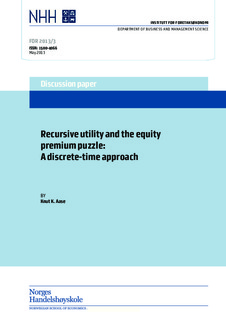| dc.contributor.author | Aase, Knut K. | |
| dc.date.accessioned | 2014-02-13T09:59:19Z | |
| dc.date.available | 2014-02-13T09:59:19Z | |
| dc.date.issued | 2013-05 | |
| dc.identifier.uri | http://hdl.handle.net/11250/164153 | |
| dc.description.abstract | We study the Epstein-Zin model with recursive utility. Recognizing that recursive preferences implies that the underlying model is not
Markovian, we use methods not depending upon the Markov property
to solve the model. We work with the returns directly, which we
approximate by Taylor series expansions, in log terms. Leaving out
moments of order three and higher, we calibrate the resulting model
to the data of Mehra and Prescott (1985) under various assumptions
about the wealth portfolio. The results are very reasonable for the
US-data. We also calibrate to a newer Norwegian data set, where
we also have the relevant estimates for the national wealth portfolio.
Again, the results are consistent with plausible values for the prefer-
ence parameters. | no_NO |
| dc.language.iso | eng | no_NO |
| dc.publisher | Norwegian School of Economics and Business Administration | no_NO |
| dc.relation.ispartofseries | Discussion papers;2013/03 | |
| dc.subject | the equity premium puzzle | no_NO |
| dc.subject | the risk-free rate puzzle | no_NO |
| dc.subject | recursive utility | no_NO |
| dc.subject | early resolution | no_NO |
| dc.subject | utility gradients | no_NO |
| dc.title | Recursive utility and the equity premium puzzle: A discrete-time approach | no_NO |
| dc.type | Working paper | no_NO |
| dc.subject.nsi | VDP::Social science: 200::Economics: 210::Business: 213 | no_NO |
